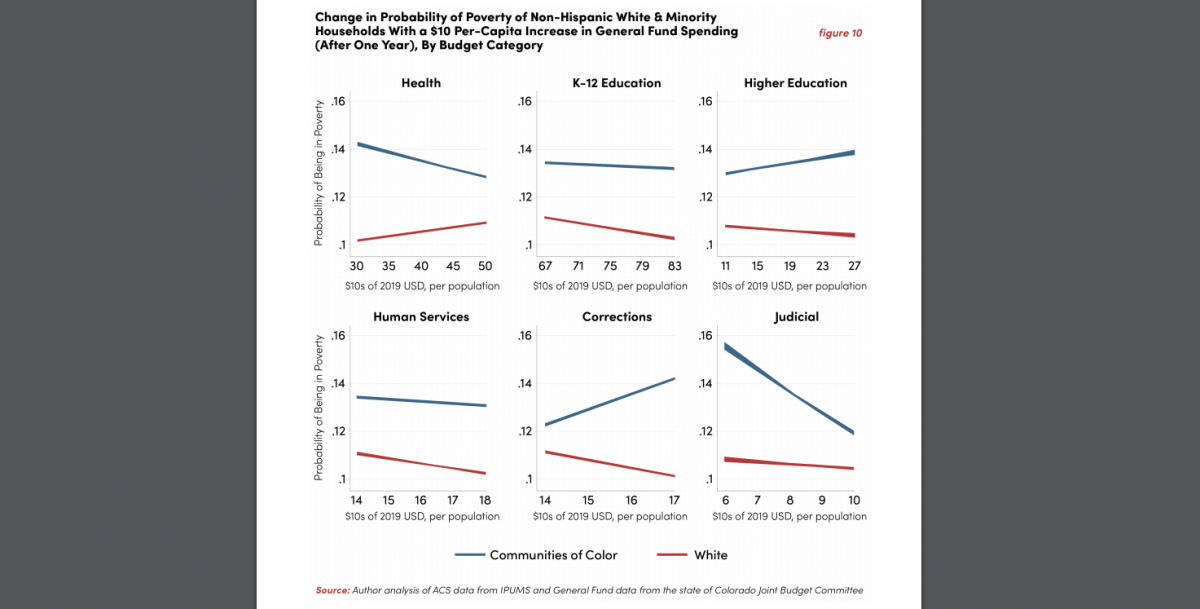Originally published on CLA SOURCE.
If Colorado wants to proactively decrease poverty levels and the income gap between white communities and communities of color, it should invest in education, the judiciary, health care and human services — instead of the corrections system.
That’s the conclusion of a recent study conducted by a Colorado State University economics professor and one of her master’s students. The ensuing report, “Economic Mobility for Low-Income Families in Colorado: The Need for Increased Targeted Public Investment,” was released Jan. 22 by The Bell Policy Center and finds that education tops the list of priorities for state funding if Colorado wants to boost the financial well-being of its low-income populations and communities of color.
Anita Alves Pena of CSU’s Department of Economics and John Singleton, who will earn his master’s degree in economics this spring, found that while Colorado’s economy has grown over the past two decades, low-income families and communities of color have not seen an increase in economic mobility as a result. They looked at the state’s “Big Six” public expenditure categories (health care, K-12 education, human services, higher education, corrections, and the judiciary) and asked themselves: If the state of Colorado were to spend $10 more on each of its residents, how should those dollars be best allocated among those six buckets?

‘An education story’
They found that investments in K-12 education and higher education would have the most impact on reducing financial inequalities and improving the economic status of low- and middle-income families.
“This is an education story, both in terms of K-12 and higher ed,” Pena said. “We found that adding public funding to those educational categories would be particularly meaningful to improve the quality of life for families in the state and reduce inequalities.”
Pena and Singleton analyzed almost 20 years of data from the American Community Survey, which is conducted as part of the U.S. Census, through 2018. They found that, when adjusted for inflation and population, the state’s public expenditures have remained stagnant during that time, and incomes have not kept pace with growing costs. In fact, in the case of higher education, state funding has decreased significantly, forcing Colorado colleges and universities to increase tuition to cover expenses. As a result, they found, fewer lower- and middle-income families can afford to send their kids to college.
“The changing costs are especially important for the generations of individuals who grew up being told to ‘go to college to get ahead in life,’” Singleton said. “That mindset was prevalent for multiple generations, but now our state investment undermines that value proposition, given the shift in costs onto individuals and families.”
Home ownership

Pena points out that having a college degree is a major factor in a person’s income, especially when it comes to home ownership, which is one of the primary ways to gain wealth. She said that boosting K-12 funding, on the other hand, tends to decrease poverty levels because of the positive effects it has on parents and families.
Secondary to education, Pena said she and Singleton were surprised at the positive role that an increase in judiciary funding would play in reducing economic gaps between demographic groups. She cited a fair and efficient court system, restorative justice programs, alternative sentencing programs and welfare support as examples of areas that, with additional financial support, would reduce disparities and bias in who gets incarcerated.
The researchers found that investments in human services, while yielding benefits lower in magnitude than boosting funds for education, would both decrease poverty and increase home ownership. Increasing financial support for health care would reduce poverty for communities of color, their results show.
“We wanted to use homeownership as a mechanism for economic mobility, given the ever-increasing cost of housing in Colorado,” Singleton said. “We wanted to link economic mobility with homeownership as a way of showing the tangible, everyday impact that targeted investments can provide.”
Among the “Big Six,” they found that increasing funding for corrections would have the greatest negative impact on communities of color.
‘Proactive, not reactive’

While the data studied was from years prior to the COVID-19 pandemic, “hopefully this tells the story of the potential,” Pena said.
“The message is to be proactive, not reactive,” she explained. “We do have to be reactive to the pandemic, but if we can invest in education, that can be helpful in both good times and bad times.”
Pena hopes that lawmakers and Colorado Gov. Jared Polis use the study as a guide for where to direct increases in state funding. Pena presented a summary of the report to the Joint Budget Committee at the state Capitol in Denver on Jan. 27.
“It’s hard to rank these areas, because it depends on what the priorities of our policymakers are,” she said. “But we were thinking about low-income Colorado families, and how to give them more upward mobility. We’re asking, ‘If you could spend more, where would you spend it?’”
The findings of the project have inspired Singleton to accept a position on the Affordable Housing Board in Fort Collins to push for easier access to affordable housing, since it is such a significant mechanism for upward economic mobility.
The research was made possible by a grant from the Rudy and Alice Ramsey Foundation through the Bell Policy Center.
Learn more
The Bell Policy Center will be hosting a free virtual presentation about the report at 5 p.m. on Tuesday, Feb. 23.
To RSVP or or for more information, visit the event web page.